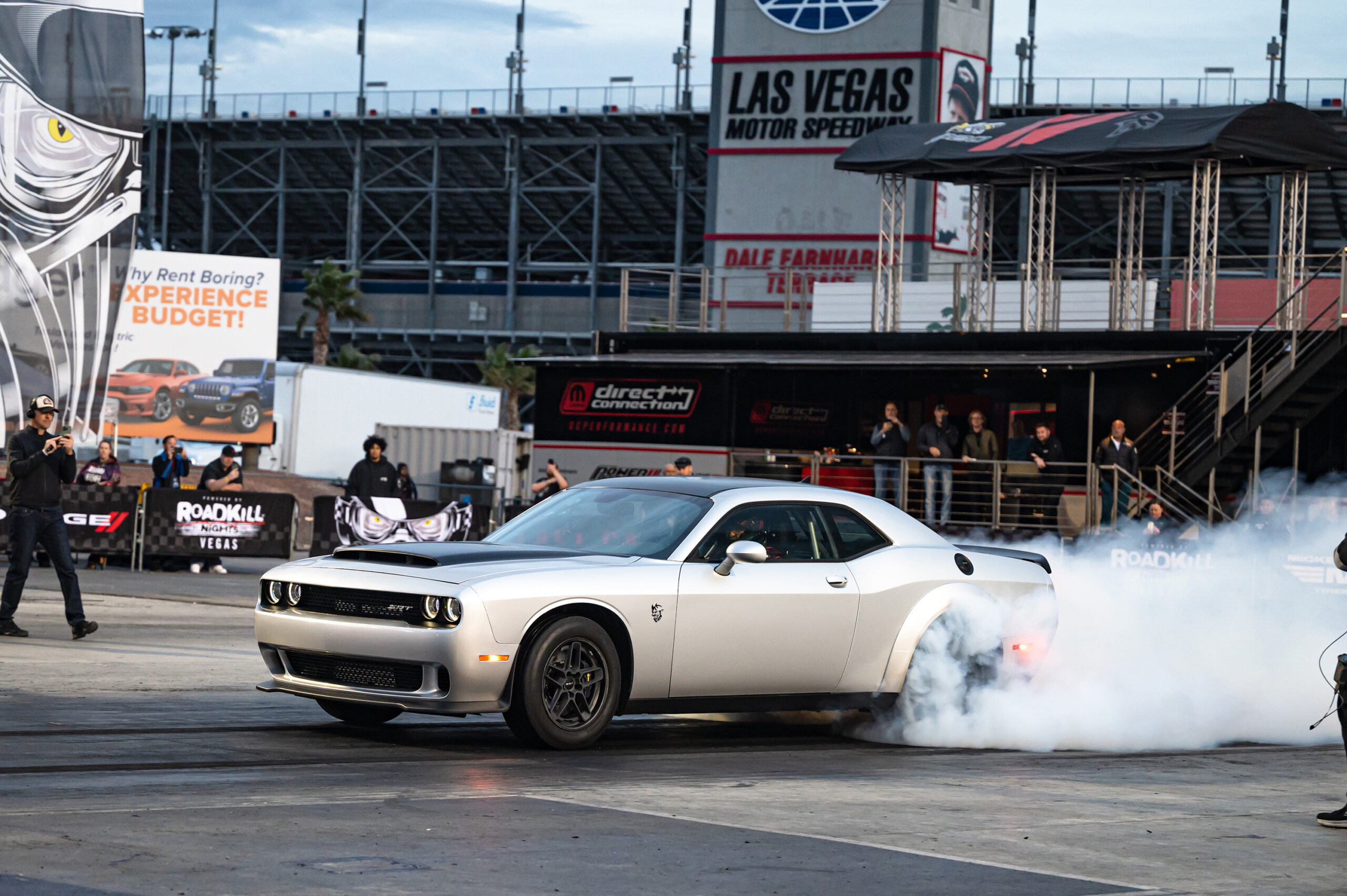Cars, especially fast cars, represent an experience that touches all the senses except taste (because biting down on metal is ill-advised). Every vehicle has a sound–even EVs–that identifies the type of powertrain propelling it. Once you’ve heard a Toyota hybrid system, it’s hard to mistake that sonorous tone for anything else. Honda hybrids have a similar sound but with their own inflection, like a Georgia native’s accent versus someone else’s twang in Texas.
A supercharger has its own specific whine, especially inside muscle cars like a Dodge Challenger Hellcat. Hearing a Hellcat go by may send chills up your spine (as it does mine) as your brain recognizes the 717 to 800-plus horsepower at the ready. The noise itself isn’t the main attraction, though. Power is the big reason automakers use superchargers from the factory, and it’s the same goal for wrenchers who want to boost their engines’ capacity for horsepower.
 Dodge’s supercharged Challenger SRT Hellcat using its hot air. Image: Dodge
Dodge’s supercharged Challenger SRT Hellcat using its hot air. Image: Dodge
Superchargers, like turbochargers, are air compressors that feed oxygen to the engine. As part of the intake stroke, a supercharger pulls and squeezes air into the engine to create that beastly whine. Mobil oil explains the differences between turbocharging and supercharging as such: “Turbochargers use the vehicle’s exhaust gas; two fans–a turbine fan and a compressor fan–rotate from exhaust gas. Conversely, superchargers are powered directly by the engine; a belt pulley drives gears that cause a compressor fan to rotate.”
To really blow your mind, know that a car can be turbocharged and supercharged at the same time. These twin-charged vehicles are rare, but they’re out there.
Supercharger types
Superchargers were invented back in the late 1800s; prolific German inventor Gottlieb Daimler received a patent for supercharging an internal combustion engine in 1885. Today, there are basically three types of superchargers: roots, twin-screw, and centrifugal.
 Superchargers have been around 150 years, and they keep improving. Image: Dodge
Superchargers have been around 150 years, and they keep improving. Image: Dodge
The roots version, which uses two rotors to push high-volume air into the motor then compressed into the manifold, is the kind you might see poking out of a hood at a hot rod show. Twin-screw is an evolution of the Roots brothers’ design, using specific rotor shapes to compress air as the rotors turn. And centrifugal superchargers look like their turbocharger cousins, employing a compact, round shape. A centrifugal supercharger uses natural centrifugal energy (which moves away from the center) to force additional oxygen into an engine, increasing airflow to burn more fuel. As a result, the engine can crank out more power.
“Centrifugal superchargers by design tend to be more efficient than more conventional roots style superchargers,” Specialty Equipment Market Association (SEMA) Chairman Kyle Fickler told PopSci. As a family of drag-racing champions, Fickler, his daughter Danika, and his wife Debra are bona-fide speed and power experts.
Fickler also works with ProCharger, which manufactures superchargers. The company advertises a 215-horsepower gain for a 6.4-liter engine with one of its centrifugal superchargers, or a 160-horsepower boost when working with a 5.7-liter Hemi. In essence, what the company is selling is the option to transform a lower-trim Dodge Challenger into a Hellcat for a lower price. A Challenger SRT Hellcat sticker price might top $80,000, so it’s cheaper to add a supercharger to a lower-priced model for about $7,000. For those comfortable tinkering with their engine setup, it may sound like a no brainer.
Not just for muscle cars
Sure, superchargers can boost speed, but that’s not their only function. A supercharger is a cost-effective and smart way to add power to a truck to improve towing and hauling capability as well.
Ford figured that out with its F-150 Raptor R, which boasts a 5.2-liter supercharged V8 engine delivering 700 horsepower and 640 lb.-ft. of torque. It’s quick from the start, and it can also catch air while bolstered by high-end Fox shocks. The brand says it recalibrated the Raptor R’s supercharger, installing a new pulley to increase torque delivery at the low-end and mid-range and increase off-road power. It also augments the truck’s towing power up to 8,200 pounds.
 The 2023 F-150 Raptor R boasts a newly modified supercharger for off-roading power. Image: Ford
The 2023 F-150 Raptor R boasts a newly modified supercharger for off-roading power. Image: Ford
Boosting power isn’t out of the question for sedans, either, but they’re going electric. Genesis uses a 48-volt mild-hybrid paired with an electric supercharger in its sleek G90 sedan, as does Audi’s S7. In these cases, the supercharger allows the twin turbos to build turbo boost pressure, eliminating that pesky turbo lag that can delay acceleration.
Whether you’re starting with a factory-installed supercharged engine or an aftermarket add-on, these compressors contribute a lot more than hot air. And the delicious sound of a whining supercharger is a bonus.

>>> Read full article>>>
Copyright for syndicated content belongs to the linked Source : Popular Science – https://www.popsci.com/technology/science-of-superchargers-engine/

















![[News] Japan Develops 10nm Nanoimprint Technology, with Potential to Tackle EUV Bottleneck – TrendForce](https://earth-news.info/wp-content/uploads/2025/12/329851-news-japan-develops-10nm-nanoimprint-technology-with-potential-to-tackle-euv-bottleneck-trendforce-360x180.jpg)













